Equipment
Low Cost DIY Rebreather Testing: Why and How
Third party rebreather testing is expensive and arguably provides limited data to users and or rebreather builders about scrubber performance. As such, it is rarely used by manufacturers to explore “What-Ifs” i.e., what would be the effect on scrubber duration if we insulated this or modified that? Fortunately, former American Underwater Products Chief Technology Officer Chauncey Chapman has developed a low cost, build-it yourself tester he calls the “Surface Normalized One-ATA Rebreather Tester,” aka SNORT, which can be built for less thaUS$3000-$5000. Download build instructions and a bill of materials. DIY testing anyone?
By Chauncey Chapman. Header image: Components of the Surface Normalized One-ATA Rebreather Tester, or S.N.O.R.T courtesy of C. Chapman
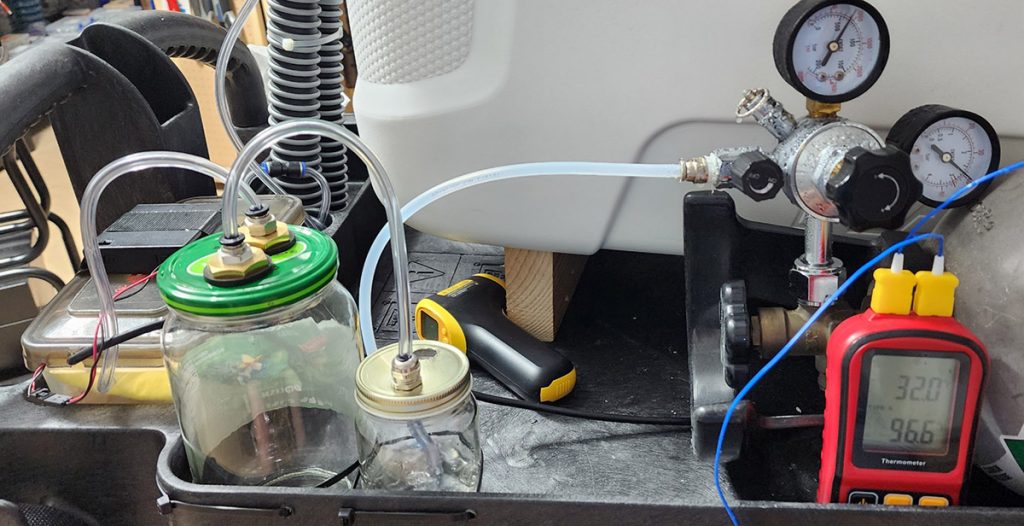
BioMarine developed the first modern rebreather—the MK15—in the 1970s for the US Navy. The critical component was the scrubber, and the Navy developed a method to test scrubber duration. The test method simulates human rebreather diving.
This test method has six controlled elements:
- Water temperature: The Navy uses a standardized water temperature of 4° C/40° F. Researchers can maintain the temperature within a small range using a circulating refrigeration unit.
- Depth: To assess performance at depth, researchers place the unit in a pressure chamber. The chamber has ports for chilled water circulation, depth control, temperature probes, pressure transducers, sample lines, and attachment to an external breathing machine. While the function of the depth chamber is standardized, the chamber designs in use differ significantly one to another.
- Breathing rate: External breathing machines can vary breath size and breathing rate, or breaths per minute. Standard breathing rates are measured in Respiratory Minute Volume (RMV). Forty RMV is used for baseline scrubber duration testing—this rate represents a heavy workload, and in testing where workload is simulated as a continuous value, no rest stops. Three standard RMVs used in rebreather testing are
- A 2 liter breath 20 times a minute (or 40 RMV)
- A 2.5 liter breath 25 times a minute (or 62.5 RMV)
- A 3 liter breath 25 times per minute (or 75 RMV)
- Heated & humidified gas in the breathing loop – The gas divers exhale is warm and humid. To simulate a diver using a rebreather, the gas in the test breathing loop passes through a heated and humidified chamber before being “inhaled” by the breathing loop. The gas entering the rebreather is controlled to be 32° C/89° F with a relative humidity of 80%.
- Constant injection of CO2 – In human respiration, CO2 production is relative to workload. The generally accepted value is 4% of the RMV equals the CO2 production in liters. At 40 RMV, 4% is 1.6 liters of CO2 per minute. In testing, the CO2 is injected into the breathing machine at a constant rate using electronic flow meters and a needle valve or an electronic mass flow controller. CO2 injected can be verified by using a gas totalizer (total liters injected vs. test time) or by weight loss of the CO2 source cylinder.
- Measurement of CO2 in the loop at the point where the “diver” would inhale loop gas – A tap is placed in the breathing loop hose where the hose attaches to the DSV (or BOV). This extracts gas that the diver would be inhaling. That gas is piped through the depth chamber’s wall to an external CO2 analyzer. At 1 ATA, CO2 is referred to as being at the Surface Equivalent Value (SEV). Scrubber duration tests run until the breakthrough CO2 measured value is 0.5% (5 mbar) and then to 1.0% (10 mbar). The time from 0.5% to 1.0% must be more than ten minutes.
Scrubber duration results are based on several testing runs. A test requiring three runs—using stable test conditions—may have run times of 190 minutes, 205 minutes, and 197 minutes when tested with air diluent at 40 m/132 ft. To be safe, diving advice is to use the shortest test time—in this case, 190 minutes.
Keep in mind that this test method was designed for military divers: supremely fit and capable of maintaining a heavy workload for the entire dive without rest. This expectation might not be practical for the average civilian diver—can you ride a bicycle for 3+ hours at 26 kph/16 mph without rest?
We also know that water temperature, diluent gas, depth, and workload all affect scrubber duration.
ISO 17025 accredited facilities charge around $3,000 USD per day for scrubber duration testing. CE certification to the 14143 standard takes seven scrubber duration runs; on a good day, a testing facility might squeeze in two runs. This expense keeps rebreather manufacturers focused on certification to a standard, but limits exploratory testing at more reasonable work rates or water temperatures for recreational rebreather divers.
Thus, the standard rebreather scrubber duration testing may not be a perfect guideline for a recreational rebreather diver quietly taking pictures of yellowhead jawfish (or being towed by a scooter).
How can we enable low-cost, objective testing to allow exploration of how scrubber types, water temperatures, different diluent gasses affect scrubber duration?
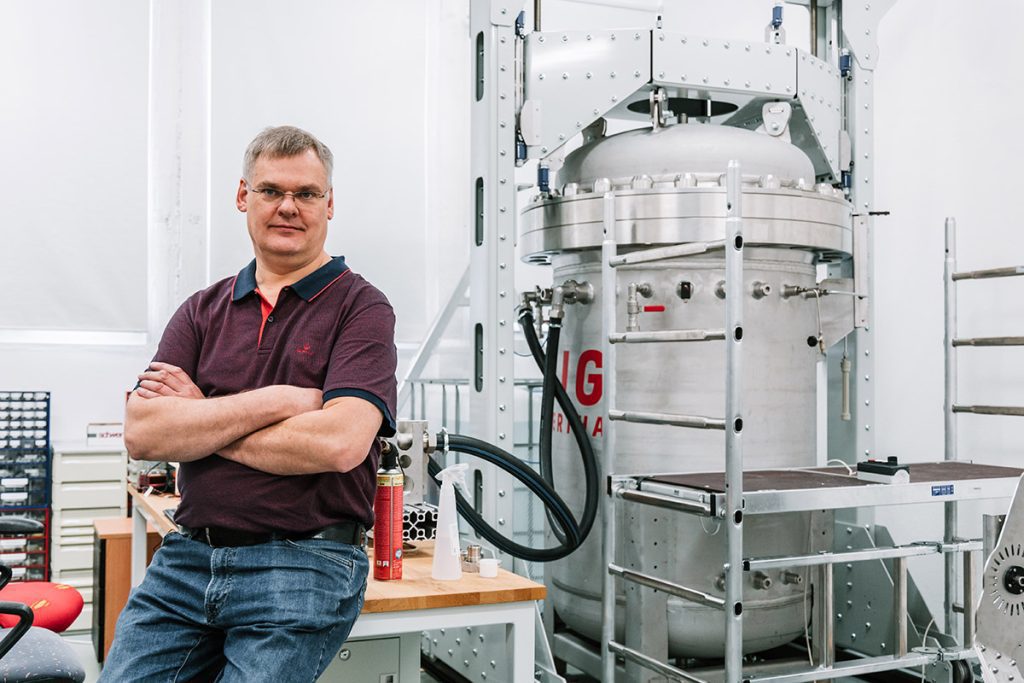
Scrubber Duration Testing For Technical Divers
As rebreather divers, we do not want to exhaust our scrubbers while diving. Depending on our diving environment, this could (at best) create a horrible experience or (at worst) precipitate a fatal event.
Just as open circuit (OC) divers always plan on ending their dives with a useful volume of gas left over, rebreather divers should never plan to completely exhaust their scrubbers while underwater. In his book, Breakthrough, Dr. John Clarke recommends a minimum buffer of 5% instead of using 100% of the tested scrubber duration—for instance, a 100 minute scrubber should be retired at or before 95 minutes of use.
But, because testers assess scrubber duration using a “heavy” workload at 4° C/40° F, the resultant duration value (expressed in minutes) may not be the best guideline for a technical diver. However, because scrubber duration testing is very expensive, testing in warmer water and at lower work rates is not being done. (N.B., the military does test at elevated temperatures and workloads, diving in the Baltic Sea vs. diving in the Persian Gulf, but the test results are not made public)
Some tech rebreather divers routinely exceed their tested scrubber duration with no adverse effects. But, it simply isn’t safe to take the standard scrubber duration test and extrapolate a safe time for use in technical diving—there are too many variables that have not been tested.
How does water temperature affect duration? Is the effect the same in every scrubber? Helium extends scrubber duration, but what % helium and by how much time? Depth must have some effect on scrubber duration, but how much? Some knowledgeable people advise that depth has a negligible effect on scrubber duration.
One way to rationalize longer scrubber use is to look at the scrubber as a CO2 sink. In standard testing, a 190-minute scrubber absorbed 304 liters of CO2 (190 X 1.6 = 304). If we are working half as hard as the test assumed, at a 20 RMV, our CO2 production would be 0.8 liters per minute. The 304 liters the scrubber absorbed would require 380 minutes to create, doubling the scrubber duration time.
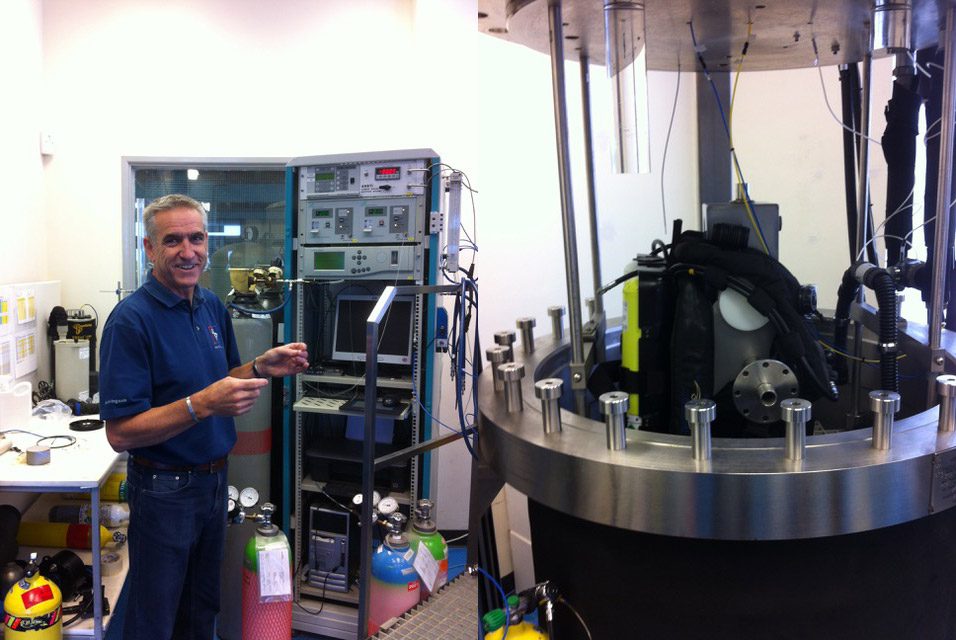
Another rationale for longer scrubber duration is based on oxygen consumption. Depending on the individual, consumption (metabolization) of 1 liter of oxygen yields between 0.75 to 1.1 liters of CO2. If you use the conservative value of 1.1 liter of CO2 per liter of oxygen, you will consume 276 liters of oxygen to generate 304 liters of CO2.
But, neither of these rationales are based on objective testing.
Using a 17025 accredited facility for testing is expensive—how can we objectively test scrubber duration for consumer applications at a much lower cost?
If we design a test system to only test scrubber duration at 1 ATA, we can bypass the most expensive elements. We need to design an inexpensive breathing machine, heat and humidity chamber, temperature-controlled water bath, accurate CO2 injection system, and accurate CO2 analyzer.
Introducing the Inexpensive Surface Normalized One-ATA Rebreather Tester, or S.N.O.R.T.
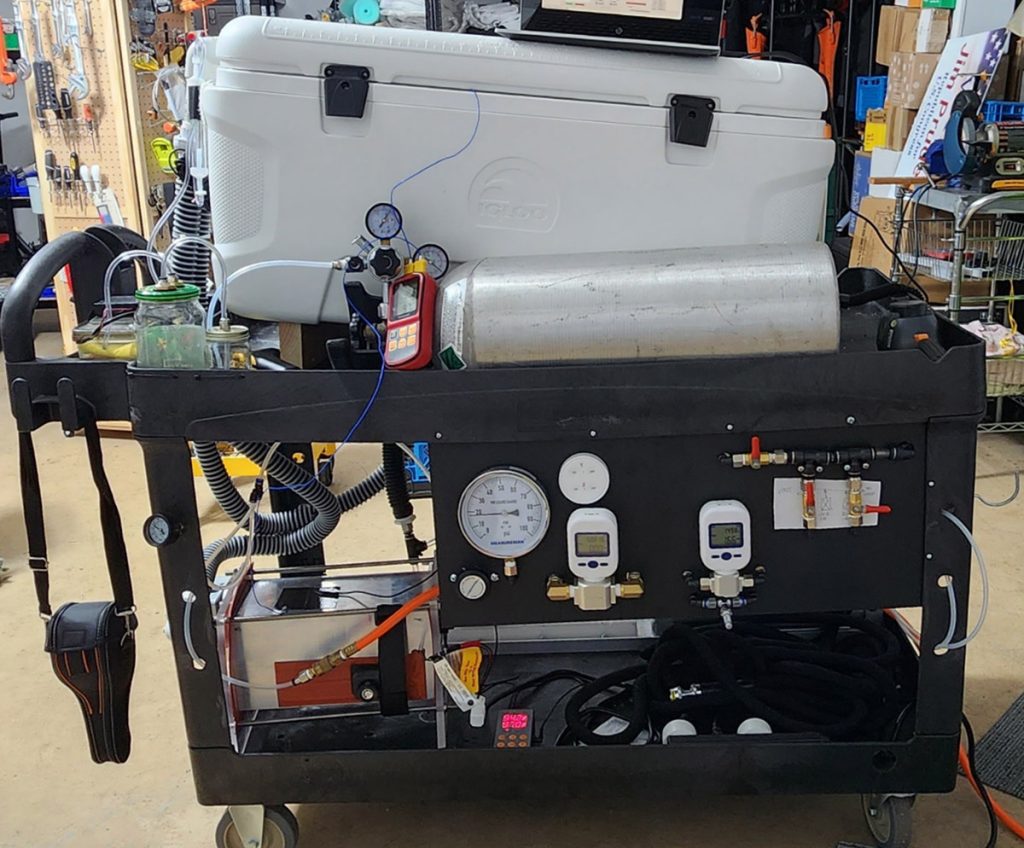
The Surface Normalized One-Atmosphere Rebreather Tester (SNORT) was conceptualized during discussions about the SCUBATRON Generic Breathing Machine (GBM), a chest-mounted rebreather, in the fall of 2021.
Like other scrubber testers, SNORT features five important subsystems:
● Temperature controlled water bath
● Breathing rate Breath volume and breaths per minute
● Exhaling warm humid gas into the rebreather
● Adding CO2 to the breathing loop
● Measuring the level of CO2 in exhaled gas
GBM designer Gregory Borodiansky and Chauncey Chapman collaborated on the design of the sub systems, and fabrication began in late 2021 on a part-time basis. In the early summer of 2022, SNORT 1 was completed and verification testing began. SNORT 1 can test a sport rebreather under conditions closely mirroring EN14143 or NEDU TM 0194. CO2 injection is measured using an electronic flow meter, continuous breathing is achieved using a regulated air pressure piston, air entering the rebreather is heated and humidified, testing occurs underwater using ice to maintain the required temperature, and CO2 breakthrough is monitored in a Windows app using a GSS CO2 sensor.
SNORT achieves the standard 40 RMV used in rebreather testing, by means of two opposing 2 liter pneumatic cylinders—one drive cylinder and one breathing cylinder. The shafts are coupled to each other. The drive cylinder has two solenoids ported to the cylinder: one normally open solenoid and one normally closed solenoid. When one set of solenoids is energized, gas can flow into that end of the drive cylinder; this moves the piston pair to cause the active port on the breathing cylinder to either inhale or exhale. There is a double pole, double throw switch mounted to the shaft coupler. When the piston has moved to each end of the stroke, an adjustable stop throws the switch to its other position, causing the piston to move back and forth. Speed is controlled by adjusting the drive air pressure.
Warming and humidifying the gas before it enters the rebreather is accomplished using a rectangular aluminum box with breathing gas ports on either end. This box is partly filled with water and has a contact heater on the outside of the box. The heater is thermostatically controlled to maintain a temperature of 31 to 33° C/88° F to 92° F. This temperature is monitored on the SNORT control panel. The breathing gas dwells in this chamber during the inhale part of the breathing cycle. The breathing gas is warmed and humidified prior to entering the rebreather.

CO2 is added to the loop by injecting CO2 into the breathing cylinder. Just like breathing rates (RMV), CO2 injection rate is defined as being 4% of the RMV. So, at 40 RMV, the CO2 injection rate is 1.6 liters per minute. SNORT uses a SIARGO MEMS (micro-electro-mechanical system) mass flow sensor and a Swagelok needle valve to inject precisely 1.6 liters of CO2 per minute, a totalizer is included for validation.
A gas sample is withdrawn from the breathing loop at the point where scrubbed gas enters the diver’s shutoff valve—this is the gas that a diver will inhale. The sample gas travels through a water trap, a NAFION tube dryer, a metering pump, and a GSS 0-5% NDIR CO2 sensor. Sample flow is visualized in a bubble chamber on the control panel. The sensor output is displayed on a computer screen and logged as a .csv file.
The rebreather under test is immersed into a water bath; the temperature of the water bath is monitored on the control panel and maintained by adding store-bought ice.

SNORT Verification Testing
SNORT verification testing: first we eliminated leaks, then explored how the CO2 sub-system worked, and verified that we had heated humidified air in the loop and could maintain 2 liter breaths 20 times a minute to achieve 40 RMV. In the initial testing, was done using:
1. The SCUBATRON Generic Breathing Machine CM rebreather
2. Performed initial dry runs
3. Completed subsequent runs with the rebreather loop underwater
4. Added runs testing lower temperatures, down to 0° C/32° F
5. Tested using air and 10/60 Trimix (10% O2, 60% He, balance N2) diluent
Once we had the system verified, we knew it could duplicate all EN14143 test requirements (except one).
Test Method Validation Testing
To validate SNORT, we tested another device—the Hollis Prism 2. We ran cold and wet tests, comparing our results to the EN14143 testing performed on the Prism 2 at the QinetiQ testing facility. We mirrored their testing protocols, simulating a 40 m/131 ft dive on air. Thanks to Nick Hollis and Hollis Rebreathers for granting access to the official Prism 2 test results.
Using the Hollis Prism 2, we compared the average scrubber duration from 3 tests done at 40 meters at the QinetiQ facility in the UK to 2 tests in our SNORT facility at a slightly colder temperature:

Note that he complete Hollis Prism 2 test results from QinetiQ can be found here: https://www.hollisrebreathers.com/technology/
In the QinetiQ testing, the three 40-meter scrubber duration test results (190 min, 197 min, 205 min) varied by 7.9% (i.e, min 190 to max of 205). In our tests, we used the same Sofnolime keg for both tests; in each test, the scrubber was packed with the same weight of Sofnolime to eliminate issues of sorb variation.
The takeaway may be that running a dive to the published scrubber duration time might not be the smartest thing to do, and arbitrarily extending a scrubber’s run time beyond the manufacturer’s published duration time is at least risky.
The low-cost SNORT system may answer some persistent questions about scrubber duration:
What is the impact of water temperature on scrubber duration?
What is the impact of trimix vs. air on duration?
What is the impact on scrubber duration of lower workloads?
How does an Axial scrubber compare to a Radial scrubber with the same gram weight of absorbent?
Does insulating an Axial scrubber extend its duration?
A Call to Action
Build your own SNORT – materials list, suppliers and their item numbers , build notes, schematics, and operation checklists can be downloaded at SNORT SCRUBBER TESTER
To reduce variables in testing, have the same person pack the scrubber for each test, and use a single keg of absorbent, weigh the scrubber before packing and after to record the weight of absorbent used in each test.
It is essential that the breathing loop and scrubber canister must be submerged in the water bath.
Developers, divers, and tinkers can then:
· Research scrubber duration in different water temperatures
· Duration at lower CO2 injection rates
· Temperature effect in axial vs. radial
· Can insulation extend scrubber duration? What works best?
· How does scrubber shape effect duration – small diameter axial vs. large diameter?
· Duration using Air diluent vs Trimix Diluent
· 8 lb scrubber vs 5 lb scrubber, which is more efficient in absorbing CO2
NOTE: Rebreather scrubber testing must be conducted in situ in the complete rebreather breathing loop. While testing in SNORT mirrors “industry standard” testing, it does not duplicate all of the test conditions; SNORT tests at 1 ATA only. Depth may have a negative impact on scrubber duration. Water temperature and diluent also affect scrubber duration. But, Dr. John Clarke notes in his book, Breakthrough, that perhaps the most impactful variable is the human in the loop: “Randomness inherent in both physics and human physiology influences the lifetime of a CO2 scrubber. Furthermore, since divers are not mechanical breathing machines built to specifications, a testing agency’s assumptions about diver physiology may not match your physiology on any given day. So, divers beware.”
Commercially available scrubber monitoring systems are available on some rebreathers:
· The xCCR gaseous CO2 sensor: Fires an alert when gaseous CO2 breaks through the scrubber
· AP Diving Temp Stick: “sees” the burn front in their axial scrubber and estimates time remaining
· Mares rEvo RMS temperature monitoring system: estimates time remaining based on thermal measurements
Dive Deeper
InDEPTH: The Secrets of Scrubbers by Jeff Bozanic (2023)
InDEPTH: InDEPTH’s Holiday Rebreather Guide: 2022 Update
InDEPTH: The Case for an Independent Investigation & Testing Laboratory by John R. Clarke PhD (2019)
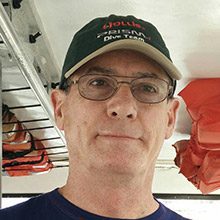
Chauncey Chapman—I love being underwater. My career started with commercial & industrial diving, then became an early PADI instructor, dive center owner, resort manager, USCG boat captain, and PADI Instructor Trainer. I thrived in all aspects of recreational diving. I was hired by American Underwater Products (Oceanic, Aeris, Hollis) in 1985 and while working for Bob Hollis took on various roles of increasing responsibility culminating in Chief Technology Officer. I was responsible for quality management, involved in product design, development, testing, manufacturing, regulatory compliance, and project manager for rebreather projects. Currently life 3.0 finds me diving as often as possible, volunteering as the treasurer for the Rebreather Training Council (RTC), working as a consultant to the recreational diving industry, and the designer of SNORT.





















































